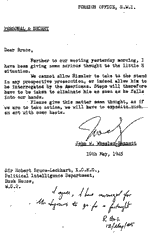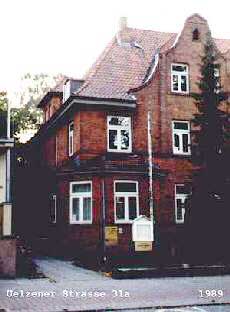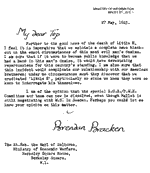| Friday, June 3, 2005;
updated Sunday, June 5, 2005
[Partial
translation in
French]
 On
May 23, 1945 Britain's secret agents had secretly
and criminally liquidated one of the most wanted
men in history, for whose proper public trial and
punishment the blood of millions of his victims
cried out. On
May 23, 1945 Britain's secret agents had secretly
and criminally liquidated one of the most wanted
men in history, for whose proper public trial and
punishment the blood of millions of his victims
cried out.
  British
archives reveal British
archives reveal
British
secret service did murder SS chief Heinrich
Himmler
(to stop him talking to the Americans) DOCUMENTS
discovered in Britain's Public Records Office,
Kew, London, confirm revisionist claims that
Himmler was liquidated by the British secret
service on Churchill's orders, and did not
commit suicide shortly after his capture as
conformist historians have long maintained.
[Partial
translation in
French] David Irving writes:
- WINSTON Churchill had long
agitated in his War Cabinet for a secret plan to be
approved between the Allied leaders ordering the
execution without trial of a number of the enemy
leaders, including Himmler. See my book "Nuremberg,
the Last Battle" and the forthcoming volume iii of
the Churchill biography. Meeting at Hyde Park in September 1944,
Churchill had readily persuaded Franklin D
Roosevelt to sign on to this plan for lynch
justice, but after Churchill carried the
document to Moscow in October 1944 Joseph
Stalin surprisingly refused to agree, insisting
instead on proper trials for all enemy war
criminals.  David
Irving recalls: IN 1999 my publishing
imprint Focal Point Publications invited
Californian writer Joe Bellinger to
speak at Cincinnati on The Strange Death
of Heinrich Himmler. He came to the same
conclusions.
Impressed by his
narrative there we paid him over $11,000
to enable him to travel to Washington and
London to complete his research.
He never made those
trips, never finished his manuscript, and
unfortunately did not learn of the files
which have now been released. THE "silencing" of Himmler raises again
the question of whether Churchill really
had been negotiating with Himmler for
nearly a year.
In August 1944 the head
of the secret service showed him at least
one document "from Himmler," and Churchill
assured the secret service chief that
after reading it he had safely destroyed
it: 'Himmler telegram kept and destroyed
by me. WSC.31.viii'.
Hitler was evidently
aware of what Himmler was up to, because
on September 12 the Reichsführer
discussed with Hitler "peace feelers to
Russia or Britain."
A few days later,
however, on September 18, 1944, the
British intercepted a German intelligence
signal that Himmler 'forbids by W/T
(wireless traffic) all contact with
English since their offers are bluff' --
as no doubt they were. See PRO file
HW.1/3196. |
Rumours emerged last year that Churchill had
personally ordered the alleged silencing of
Benito Mussolini, and that the order had
been handed by an SOE officer to Italian partisans
soon after. Mussolini and his entire Cabinet were
liquidated by machine gun squads without trial in
the closing days of the war.In April 1945, Himmler moved to northern Germany
and began negotiations through his own Intelligence
chief Walter Schellenberg and Count
Bernadotte, the Swedish emissary, to end the
bloodshed in Europe. The negotiations went through
Sir Victor Mallet, the British minister in
Stockholm. Stalin was by this time pathologically
suspicious of any separate negotiations between the
Allied governments and the Nazi leadership. Himmler
was thus the repository of some awkward secrets
when he fell into British hands in May 1945. For a while Churchill was inclined to deal with
him. Admiral Cunningham, Britain's First Sea
Lord, visited Churchill on April 13, 1945 and wrote
this startling passage in
his diary afterwards: "During our interview the PM mentioned
that Himmler appeared to be trying to show that
he wasn't so bad as painted & PM said if it
would save further expenditure of life he would
be prepared to spare even Himmler. I suggested
there were plenty of islands he could be sent
to." Real historians have long doubted the conformist
version of how Himmler died, namely that he
obligingly swallowed poison when he realised the
game was up. Patient research revealed that the official
files on his death had oddities, discrepancies, and
inconsistencies: the autopsy performed on the
corpse did not give the cause of death; a vital
page had been
retyped; there was no message in the files of
21 Army Group, Field-Marshal Sir Bernard
Montgomery's headquarters, reporting the event to
London. Whatever had been there, it had gone. Now come documents from the Public Record Office
(record group FO 800, file 868), which provide more
than just a smoking gun. What is truly
extraordinary is not so much that the conformists
have willingly overlooked the inconsistencies for
over sixty years but that those involved in, or
aware of, the murder -- who included Prime Minister
Churchill himself -- had kept quiet about it. The
documents: The
first, dated May 10, 1945 is a Personal and Secret
letter on Foreign Office stationery from Sir
John Wheeler-Bennett, later a noted
Establishment and Royal historian, to the famous
British agent Sir Robert Bruce-Lockhart, of
the Political Intelligence Department off the
Foreign office -- which conducted Black propaganda
against the enemy: The
first, dated May 10, 1945 is a Personal and Secret
letter on Foreign Office stationery from Sir
John Wheeler-Bennett, later a noted
Establishment and Royal historian, to the famous
British agent Sir Robert Bruce-Lockhart, of
the Political Intelligence Department off the
Foreign office -- which conducted Black propaganda
against the enemy:
Further to our meeting yesterday
morning, I have been giving some serious thought
to the little H situation. We cannot allow Himmler to take to the
stand in any prospective prosecution, or indeed
allow him to be interrogated by the Americans.
Steps will therefore have to been taken to
eliminate him as soon as he falls into our
hands. Please give this matter some thought, as
if we are to take action we will have to
expedite such an act with some haste. Lockhart minuted two days later in handwriting:
"I agree, I have arranged for Mr Ingrams to go
for a fortnight. R B-L, 12/May/1945." It is significant to note from the diary of
General Dempsey, commanding the British
Second Army in Northern Germany (PRO file
WO/285/12), that on Monday, May 21 he visited both
the detention camp at Westertimke and the German
concentration area between Bremervörde and
Stade. We know that Himmler and his two adjutants
Macher and Grothmann had been
arrested at Bremervörde on May 21, 1945, but
-- so the story goes -- Himmler was not identified
until they arrived at Westertimke on May 23,
1945. The former Reichsführer SS was carrying a
letter to Field Marshal Sir Bernard
Montgomery, the British field commander (which
has vanished). His only cyanide capsule was found
in his clothing after he had been ordered to strip
naked, and it was handed to Michael Murphy, head of
British  Intelligence
at the Second Army. According to The Illustrated
London News story a few days later, a
"second" capsule was surrendered to the medical
officer at Himmler's final destination, the ominous
house at No. 31a Ülzener Strasse in
Lüneburg -- which raises a number of obvious
questions. Intelligence
at the Second Army. According to The Illustrated
London News story a few days later, a
"second" capsule was surrendered to the medical
officer at Himmler's final destination, the ominous
house at No. 31a Ülzener Strasse in
Lüneburg -- which raises a number of obvious
questions.  After
his identification, according to the official
accounts, Himmler had answered questions, eaten a
thick British Army sandwich, and been driven to the
house in Lüneburg -- from which he emerged
dead. After
his identification, according to the official
accounts, Himmler had answered questions, eaten a
thick British Army sandwich, and been driven to the
house in Lüneburg -- from which he emerged
dead.
Although the British military files appear
meticulous, even listing with suspicious detail
every person present in the room at the moment of
death, many facts did not fit into place. The prisoner's nose
had been broken, according to The
Illustrated London News artist who sketched the
body. How had he obtained the
cyanide capsule he had allegedly been hiding in
his mouth (let alone answer questions and bite into
that sandwich)? The capsule descriptions varied, and bore no
resemblance to what the standard issue capsule
actually looked like. And more (but wait for my
upcoming Himmler biography).  At
2:50 a.m. that night (it was now May 24, 1945) "Mr
Thomas" wired from Bremen to the Foreign Office for
Bruce Lockhart in a top secret code (jj jj jj jj is
the clue: it was a one-time pad). At
2:50 a.m. that night (it was now May 24, 1945) "Mr
Thomas" wired from Bremen to the Foreign Office for
Bruce Lockhart in a top secret code (jj jj jj jj is
the clue: it was a one-time pad).
"Further to my orders we
successfully intercepted H.H. last night at
Lüneburg before he could be interrogated.
As instructed action was taken to silence him
permanently. I issued orders that my presence at
Lüneburg is not to be recorded in any
fashion, and we may conclude that the H.H.
problem is ended." Bruce Lockhart significantly noted on this
telegram, "copy to PM" -- i.e., to Churchill --
"May 25".  Brendan
Bracken, Churchill's obnoxious red-headed
confidant (left, with friend: Clementine loathed
him), was also in on the action -- a war crime,
despite Heinrich Himmler's dark record, as he was a
prisoner of war who had surrendered to British
custody. Brendan
Bracken, Churchill's obnoxious red-headed
confidant (left, with friend: Clementine loathed
him), was also in on the action -- a war crime,
despite Heinrich Himmler's dark record, as he was a
prisoner of war who had surrendered to British
custody.
 "Mr
Dear Top," he wrote on May 27 to Lord Selborne at
the Ministry of Economic warfare, head of the SOE
(PRO file HS series HS8/944), "Mr
Dear Top," he wrote on May 27 to Lord Selborne at
the Ministry of Economic warfare, head of the SOE
(PRO file HS series HS8/944),
"Further to the good news of the
death of Little H, I feel it is imperative that
we maintain a complete news blackout on the
exact circumstances of this most evil man's
demise. I am sure that if it were to become
public knowledge that we had had a hand in this
man's demise, it would have devastating
repercussions for this country's standing." Quite so: Britain's secret agents had secretly
and criminally liquidated one of the most wanted
men in history, for whose proper public trial and
punishment the blood of millions of his victims
cried out: and for no other visible reason than to
conceal that for a few days toward the end of the
war, Churchill had negotiated with him on peace
terms. "I am also sure [continued
Bracken] that this incident would complicate
our relationship with our American brethren;
under no circumstances must they discover that
we eradicated 'Little H', particularly so since
we know they were keen to interrogate him
themselves.I am of the opinion that the special
SOE/PWE Committee and team can now be dissolved,
even though Mallet is still negotiating with
W.S. [Walter
Schellenberg] in Sweden.
Perhaps you could let me know your opinion on
this matter."  REAL historians will now need to do further work to
identify the murderer, "Mr Thomas," and the part
played by Robert Bruce-Lockhart, who was a
principal figure in Britain's Black propaganda war
together with Sefton Delmer.
REAL historians will now need to do further work to
identify the murderer, "Mr Thomas," and the part
played by Robert Bruce-Lockhart, who was a
principal figure in Britain's Black propaganda war
together with Sefton Delmer.
Bracken ordered that all his papers be destroyed
before his death. Bruce-Lockhart's diaries and
papers are in the Hoover Institution at Stanford
University, California; a sanitized edition of his
diaries was published many years ago, and his
papers have probably been weeded too. It is known that when Himmler first established
contact with the British, Churchill's initial
response was to deal with him regardless of his
reputation. But then the secret services stepped
in. A fake communiqué was issued claiming
that Himmler had offered to betray Hitler, and this
caused much confusion and fury in Hitler's bunker
in the last few days -- not to mention anguish to
Himmler himself. Until the last moment, he believed that he was
to meet Montgomery, and when he took off his eye
patch and identified himself as Himmler to the
British camp commandant, he believed that he would
be in the presence of the British commander soon
after. Instead, as Colonel Michael Murphy wrote
in a handwritten
report in an odd turn of phrase to which we
drew comment two months ago, "I therefore told him
to dress, and wishing to have a medical search
conducted, telephoned my G-II at my H.Q. and told
him to get a Doctor to stand by at a house I had
had prepared for such men as Himmler." This was the
house from which Himmler emerged lifeless, wrapped
in a blanket. Many months ago we had already detected
that page 2 of the three-page report in the British
Second Army intelligence unit's war diary,
recording Himmler's death, had been retyped at
roughly  the
same time -- on the same report pad and using the
same typewriter, but by a different hand: clearly
indicating that it had been sanitized for some
purpose which could only be surmised. the
same time -- on the same report pad and using the
same typewriter, but by a different hand: clearly
indicating that it had been sanitized for some
purpose which could only be surmised. Now we know why. Our
thanks to Steve
Kippax
in London for additional research and providing
the document scans. Kippax's special interest is
in the British and German Special Forces in WWII
and after, and he has studied SOE, OSS, Abwehr
and SD in depth [Partial
translation in
French] 
 Radical's
Diary No.26: " I noticed that page 2 of the
1945 Second Army diary, which relates this
episode at length, has
been retyped on the same typewriter as used
for pages 1 and 3, but by a different
typist."
Radical's
Diary No.26: " I noticed that page 2 of the
1945 Second Army diary, which relates this
episode at length, has
been retyped on the same typewriter as used
for pages 1 and 3, but by a different
typist." Illustrated London
News runs early story on the "suicide" of
Himmler
Illustrated London
News runs early story on the "suicide" of
Himmler "Sergeant Carl Sutton," or "Norman
Redford" took illicit photos of the
body
"Sergeant Carl Sutton," or "Norman
Redford" took illicit photos of the
body Description in Feb
1964 by former colonel (British Army) Michael
Murphy on the death of Heinrich Himmler, May
1945, written to biographer Heinrich
Fraenkel
Description in Feb
1964 by former colonel (British Army) Michael
Murphy on the death of Heinrich Himmler, May
1945, written to biographer Heinrich
Fraenkel Selkirk Panton
writes (May 1954) on Himmler's end
Selkirk Panton
writes (May 1954) on Himmler's end Sunday Times
publishes new Hitler, Himmler photos
Sunday Times
publishes new Hitler, Himmler photos War
diary on death of Himmler, and Substance of
Message from GS9 2nd Army 24 May 45 to GS9 21 A
Gp
War
diary on death of Himmler, and Substance of
Message from GS9 2nd Army 24 May 45 to GS9 21 A
Gp
|